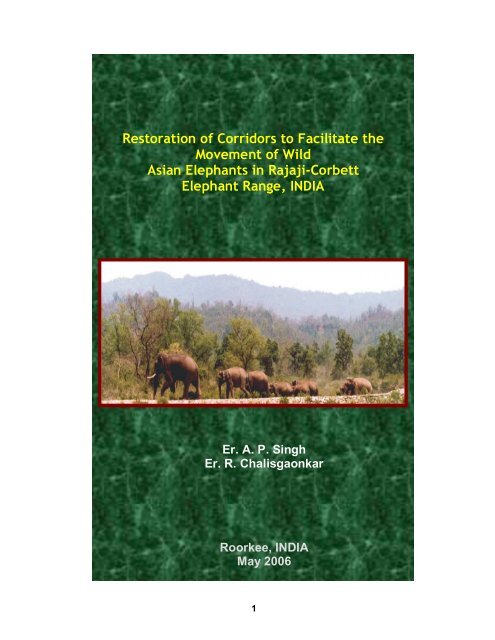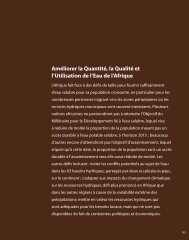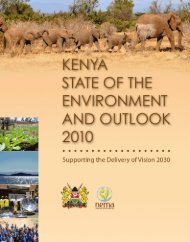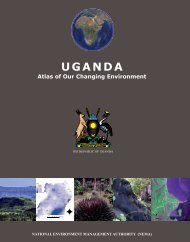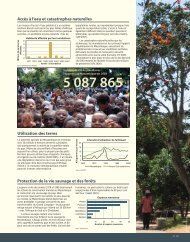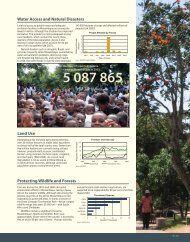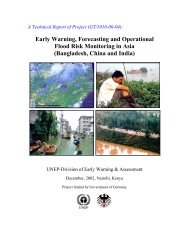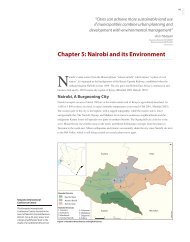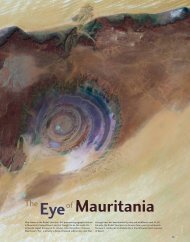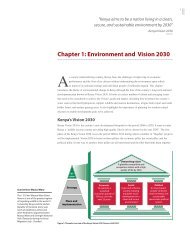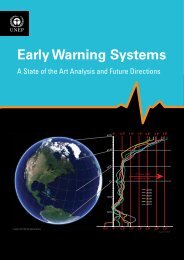Restoration of Corridors to Facilitate the Movement of Wild Asian ...
Restoration of Corridors to Facilitate the Movement of Wild Asian ...
Restoration of Corridors to Facilitate the Movement of Wild Asian ...
Create successful ePaper yourself
Turn your PDF publications into a flip-book with our unique Google optimized e-Paper software.
<strong>Res<strong>to</strong>ration</strong> <strong>of</strong> <strong>Corridors</strong> <strong>to</strong> <strong>Facilitate</strong> <strong>the</strong><br />
<strong>Movement</strong> <strong>of</strong> <strong>Wild</strong><br />
<strong>Asian</strong> Elephants in Rajaji-Corbett<br />
Elephant Range, INDIA<br />
Er.A.P.Singh<br />
Er.R.Chalisgaonkar<br />
Roorkee,INDIA<br />
May2006<br />
1
OBJECTIVE<br />
Indiahas<strong>the</strong>largestnumber<strong>of</strong><strong>Wild</strong><strong>Asian</strong>Elephant s(19,000<strong>to</strong>29,000)andhas<br />
a discontinuous distribution in nor<strong>the</strong>rn, eastern a nd sou<strong>the</strong>rn ranges. North-<br />
Western Elephant Range is among <strong>the</strong> important eleph ant areas in India and<br />
Rajaji and Corbett National Parks along with Lansdo wne Forest Division and<br />
Sonanadi Forest Division are <strong>the</strong> main important hab itat in this range.<br />
Development <strong>of</strong> railline, highways, irrigation and h ydroelectric canals,industrial<br />
establishments, human settlements along <strong>the</strong> migrati on corridors have<br />
fragmented <strong>the</strong> area and adversely affected <strong>the</strong> migr a<strong>to</strong>ry movements <strong>of</strong> <strong>the</strong><br />
elephants.Thesecorridorsarehowevernecessary<strong>to</strong> facilitatedispersaland<strong>the</strong><br />
migrationprocesses,whicharecritical<strong>to</strong>species persistence.<br />
The report suggests <strong>the</strong> alternatives and modifications in <strong>the</strong> man<br />
made (Civil Engineering) structures <strong>to</strong> facilitate <strong>the</strong> movement <strong>of</strong><br />
Elephants, save this endangered species from extinction and avoid<br />
<strong>the</strong> animal-human conflict in <strong>the</strong> Rajaji –Corbett Elephant Range.<br />
Detailed project has been formulated on <strong>the</strong> basis <strong>of</strong> elephant’s<br />
behaviour <strong>to</strong>wards <strong>the</strong> different existing civil engineering structures<br />
in and around <strong>the</strong> habitat for <strong>the</strong> construction <strong>of</strong> <strong>the</strong> new passages<br />
and modification/res<strong>to</strong>ration <strong>of</strong> <strong>the</strong> existing structure at different<br />
locations. The estimated project will cost approximately 4.5 million<br />
U S Dollar.<br />
Itisexpectedthat<strong>the</strong>proposalssuggestedin<strong>the</strong> reportshallbeable<strong>to</strong>res<strong>to</strong>re<br />
<strong>the</strong>lostcontinuityin<strong>the</strong>movement<strong>of</strong>elephantsin <strong>the</strong>Rajaji–CorbettElephant<br />
Range,India<strong>to</strong>agreatextent.<br />
Er.AjayPalSingh<br />
ExecutiveEngineer,UttarPradeshStateIrrigation Department<br />
MadhyaGangaCanalDivision<br />
Meerut,(U.P.),INDIA<br />
Er.RajendraChalisgaonkar<br />
ExecutiveEngineer,UttarakhandStateIrrigationDe partment<br />
Dehradun–248001,INDIA<br />
2
CONTENTS<br />
S.No. Title Page<br />
No.<br />
1. Introduction 4<br />
2. Rajaji–CorbettElephantConservationRange 6<br />
2.1 RajajiNationalPark 6<br />
2.2 CorbettNationalPark 7<br />
2.3 ChillaMotichurCorridor 7<br />
2.4 Rajaji–CorbettCorridor 7<br />
3. PsychologyandBehaviour<strong>of</strong>Elephants 8<br />
3.1 Migration 8<br />
3.2 PsychologyandBehaviour 8<br />
3.3 FoodHabits 8<br />
4. ProblemsFacedby<strong>Wild</strong><strong>Asian</strong>Elephantsinand<br />
8<br />
aroundRajajiNationalPark<br />
4.1 Haridwar–Rishikesh/DehradunHighway 9<br />
4.2 Haridwar–Rishikesh/DehradunRailline 9<br />
4.3 ChillaPowerChannel 9<br />
4.4 EasternGangaCanal 9<br />
4.5 Kotdwar–Lansdowne/PauriHighway 10<br />
4.6 RecentIncident 10<br />
5. Behaviour<strong>of</strong>Elephantsand<strong>the</strong>Requirementfor<strong>the</strong><br />
Design<strong>of</strong>Passages<br />
11<br />
6. Solution:Construction<strong>of</strong>Ec<strong>of</strong>riendlyStructures for 12<br />
Elephants<br />
6.1 Construction<strong>of</strong>ElevatedHighways 12<br />
6.2 Construction<strong>of</strong>Ec<strong>of</strong>riendlyOverpasses 13<br />
6.3 Ec<strong>of</strong>riendlyBridgeson<strong>the</strong>Channels 14<br />
6.4 WaterTanks–AnAlternateSource<strong>of</strong>Water 15<br />
7. Proposal<strong>to</strong><strong>Facilitate</strong><strong>Movement</strong><strong>of</strong>Elephantsin<br />
Rajaji–CorbettElephantRange<br />
7.1 MitigationStructuresforRaillineandRoadb<br />
MotichurandRaiwala<strong>to</strong>wn<br />
etweenriver<br />
7.1.1 Construction <strong>of</strong> elevated highway bridge for <strong>the</strong> ro<br />
only(Alternative-I)<br />
ad<br />
7.1.2 Construction <strong>of</strong> combined overpasses on <strong>the</strong> west side<br />
<strong>of</strong>riverGangesonRailroadandHighway(Alternat ive-II)<br />
7.2 Rivertrainingworks<strong>to</strong>protectleftbank<strong>of</strong>r iverMotichur<br />
andres<strong>to</strong>ration<strong>of</strong>forestpatchup<strong>to</strong><strong>the</strong>riverGa nga<br />
7.3 Extension<strong>of</strong>BridgeonChillaPowerChannelat<br />
chainage12.50km<br />
7.4 Construction<strong>of</strong>WaterTanksinRajajiNational<br />
ChillaPowerChannel<br />
Parknear<br />
7.5 Construction<strong>of</strong>NaturalPassageover<strong>the</strong>exist ing<br />
Kotdwar–Lansdowne/PauriRoad<br />
8. Cost<strong>of</strong>Proposal 25<br />
9. Conclusions/Recommendations 25<br />
3<br />
16<br />
16<br />
16<br />
16<br />
20<br />
21<br />
22<br />
24
1.0 INTRODUCTION<br />
Habitatfragmentationisaproblemfacedbymanysp eciesallover<strong>the</strong>worlddue<br />
<strong>to</strong>expansionsinurbansettlementsandinfrastructu redevelopmentalactivities.It<br />
hasdestroyedandfragmented<strong>the</strong>habitats<strong>of</strong>animal sandduet<strong>of</strong>ragmentation,<br />
<strong>the</strong>migrationbetween<strong>the</strong>sefragmentedareashasbe engreatlyhampered.Asa<br />
result many species are threaded in <strong>the</strong>ir existence , some even facing (local)<br />
extinction.<br />
One<strong>of</strong><strong>the</strong>speciesfacing<strong>the</strong>seproblemsis<strong>the</strong>Asi anelephant,as<strong>the</strong>yrequire<br />
largeareas<strong>of</strong>naturalrangethananyo<strong>the</strong>rmammal speciesintropicalAsia,and<br />
<strong>the</strong>refore are one <strong>of</strong> <strong>the</strong> main animals <strong>to</strong> suffer <strong>the</strong> consequences <strong>of</strong><br />
developmentalactivities.Theirnumbersarereduced <strong>to</strong>around35,000<strong>to</strong>50,000<br />
in<strong>the</strong>wild.Thepresentdistribution<strong>of</strong><strong>the</strong><strong>Asian</strong> elephantcoversonlyafraction<strong>of</strong><br />
itsformerextensiverange,andincludes13countri es,stretchingfrom<strong>the</strong>Indian<br />
subcontinent in <strong>the</strong> west <strong>to</strong> Indochina in <strong>the</strong> east. They inhabit a land area <strong>of</strong><br />
about 444,000 km 2 , out <strong>of</strong> which only about 130,000 km<br />
4<br />
2 (30%) has been<br />
declared as protected area. Elephant population in Asia is small in size and<br />
highly fragmented, with fewer than 10 populations c omprising more than 1000<br />
individualsinacontiguousarea(Kemf&Santiapill ai,2000).<br />
AFRICAN:400,000-600,000<br />
ASIAN:35,000-50,000<br />
INDIAN:19,000-29,000<br />
NORTH WESTERN ELEPHANT RANGE<br />
(ELEPHANT POPULATION : 1,500)<br />
Fig.1-PresentGeographicDistribution<strong>of</strong><strong>Asian</strong>Ele phants<br />
India has <strong>the</strong> largest number <strong>of</strong> <strong>Asian</strong> elephants in its wild (19,000 <strong>to</strong> 29,000).<br />
Population <strong>of</strong> <strong>the</strong> <strong>Asian</strong> elephants in India nowadays has a discontinuous<br />
distributioninnor<strong>the</strong>rn,easternandsou<strong>the</strong>rnrang es.Theyarelargelyrestricted<br />
<strong>to</strong> <strong>the</strong> foothill areas because <strong>the</strong>ir natural habitat in <strong>the</strong> fertile river valleys has<br />
been taken over by humans for agriculture, industri al and o<strong>the</strong>r purposes.<br />
Keepingthisinview,<strong>the</strong>Government<strong>of</strong>Indiaenact eda<strong>Wild</strong>LifeProtectionact<br />
in1972(schedule–I)andhasdeclared<strong>the</strong>elephan tsas Endangeredspecies<br />
byputtingitin<strong>the</strong>first<strong>of</strong><strong>the</strong>sixthschedule<strong>of</strong> animals&plants.Simultaneously<br />
in 1975, this flag ship species is classified as Endangered and listed in
Appendix I<strong>of</strong> <strong>the</strong> Conventionon International Trade inEndangeredSpecies <strong>of</strong><br />
FloraandFauna(CITES).<br />
In<strong>the</strong>past,<strong>the</strong>elephants used<strong>to</strong>migratefreelyi n<strong>the</strong>foothills <strong>of</strong>Himalayas in<br />
search <strong>of</strong> water and fodder from river Yamuna <strong>to</strong> riv er Brahmaputra covering<br />
nearly1300km.Mostly<strong>the</strong>elephant'shabitatsare near<strong>the</strong>perennialriversand<br />
manycivilengineeringstructuresarealsoconstruc tedon<strong>the</strong>perennialrivers<strong>to</strong><br />
drawwaterforirrigationandgeneratingpower.Man ycivilengineeringstructures,<br />
suchasraillines,highways,canals,etc.construc tedin<strong>the</strong>habitatsandmigration<br />
corridors, have adversely effected <strong>the</strong> movement <strong>of</strong> elephants and fragmented<br />
long migra<strong>to</strong>ry routes in isolated zones. According <strong>to</strong> <strong>the</strong> 2005 census <strong>of</strong> <strong>Wild</strong><br />
<strong>Asian</strong> Elephants, <strong>the</strong>re are about 1510 elephants bet ween river Yamuna and<br />
Indo-Nepal border in <strong>the</strong> nor<strong>the</strong>rn region <strong>of</strong> state o f Uttaranchal, which extend<br />
overalength<strong>of</strong>400kmandfragmentedin<strong>to</strong>severa lisolatedzones.Themajor<br />
four fragmented zones, which harbours about 90 perc ent <strong>of</strong> <strong>the</strong> elephant<br />
population<strong>of</strong><strong>the</strong>NorthWesternElephantConservati onZonearebetween<br />
(i) riverYamunaandriverGanges<br />
(ii) riverGangesandriverKho<br />
(iii) riverKhoandriverKosiand<br />
(iv) riverKosiandriverSharda.<br />
In <strong>the</strong>se zones, <strong>the</strong> hilly <strong>to</strong>rrents are notvery ste ep, passes through <strong>the</strong> deep<br />
forest facilitating <strong>the</strong> movement <strong>of</strong> wild elephants, but various structures<br />
constructed on <strong>the</strong>se hilly <strong>to</strong>rrents cause hindrance in <strong>the</strong> movement <strong>of</strong><br />
elephants.<br />
Fig.2-NorthWesternElephantConservationRange<br />
5
2.0 RAJAJI–CORBETTELEPHANTCONSERVATIONRANGE<br />
Rajaji National Park and <strong>the</strong> Corbett National Park with Lansdowne Forest<br />
Division and Sonanadi Forest Division are <strong>the</strong> main important habitat <strong>of</strong><br />
elephants in this range. Development <strong>of</strong> railroads, highways, irrigation and<br />
hydropower channels, industrial and residential est ablishments near <strong>the</strong> river<br />
banks, humansettlements along <strong>the</strong> migrationcorrid ors aremainly responsible<br />
for<strong>the</strong>fragmentation<strong>of</strong><strong>the</strong>habitat<strong>of</strong>elephants(F ig.3).Nowadays,<strong>the</strong>corridors<br />
betweenRajajiNationalPark andCorbettNational Park,necessaryt<strong>of</strong>acilitate<br />
dispersal and <strong>the</strong> migration processes, critical <strong>to</strong> species persistence, are no<br />
longerusedbyelephantsdue<strong>to</strong>varioushurdles.Fu turedevelopmentalprojects<br />
in<strong>the</strong>areawithoutpropermitigationmeasureswill worsen<strong>the</strong>problem.<br />
2.1RajajiNationalPark<br />
Fig.3-LinearDevelopmentsinRajajiNationalPark<br />
TheRajajiNationalParkislocatedin<strong>the</strong>foothill s<strong>of</strong>ShivalikrangeandGarhwal<br />
Himalayas between 29 0 52’ <strong>to</strong> 30 0 16’N and 77 0 52’ <strong>to</strong> 78 0 22’E in Haridwar,<br />
DehradunandPauridistricts <strong>of</strong>Uttaranchal.Theal titude<strong>of</strong><strong>the</strong> mainportion<strong>of</strong><br />
<strong>the</strong>parklies around365maboveM.S.L.The Ganges f lows 24kmthrough<strong>the</strong><br />
parkdividingitin<strong>to</strong>twounequalhalves,withaco rearea<strong>of</strong>820km 2 .Thewestern<br />
portionoccupies571km 2 (rightbank)and<strong>the</strong>easternportioncovers249km<br />
6<br />
2 (left<br />
bank). The park has significantconservationvalues . It includes alarge area<strong>of</strong><br />
<strong>the</strong>fragileShivalikecosystem.Thefaunaandflora <strong>of</strong>this regionaresimilar <strong>to</strong><br />
that <strong>of</strong> <strong>the</strong> Himalayan and <strong>the</strong> Gangetic Plains. The <strong>Asian</strong> Elephant ( Elephas<br />
maximus) is <strong>the</strong> most important flagship specie found in th e Park. The Rajaji<br />
NationalPark(820km 2 )consists<strong>of</strong>mainlymoistdeciduousforestswithr iparian<br />
forests along<strong>the</strong>river.Thereareapproximately41 6<strong>Asian</strong>elephants(79males,<br />
187femalesand150calves)inthisParkasper<strong>the</strong> 2005censuscarriedoutby<br />
<strong>the</strong> park authorities. O<strong>the</strong>r common herbivores livin g in <strong>the</strong> park are Sambar,<br />
Chital, Barking Deer, Goral, Nilgai, Common Langur and Rhesus Monkey.<br />
Omnivores present in <strong>the</strong> park include Sloth Bear, W ild Bear and Indian Palm
Civet and <strong>the</strong> carnivores present are Tiger, Leopard , <strong>Wild</strong> Dog, Jackal and<br />
Hyaena.<br />
2.2CorbettNationalPark<br />
The Corbett National Park (521 km 2 ) is <strong>the</strong> homeland <strong>of</strong> approximately 560<br />
elephants (84males,274females and202calves) as per 2005cencus carried<br />
outby<strong>the</strong>projectauthoritiesandlies110kmint heeastfromriverGanges.Both<br />
national parks, <strong>to</strong>ge<strong>the</strong>r with <strong>the</strong> areas connecting <strong>the</strong>m, form <strong>the</strong> North –<br />
Western elephant range (about 4000 km 2 ), is homeland <strong>of</strong> 1510 <strong>Wild</strong> <strong>Asian</strong><br />
Elephants.<br />
2.3Chilla-MotichurCorridor<br />
TheChilla-Motichurcorridorliesacross<strong>the</strong>river Gangesandconnect<strong>the</strong>eastern<br />
(249km 2 )andwestern(571km 2 )part<strong>of</strong><strong>the</strong>RajajiNationalPark.Thecorridoris<br />
approximately3kmlongand1kmwide.ThisCorrido risformedby<strong>the</strong> Motichur<br />
<strong>to</strong>rren<strong>to</strong>n<strong>the</strong>westbankand Sonisot,Mundal and Ghasiramsot <strong>to</strong>rren<strong>to</strong>n<strong>the</strong><br />
eastbankjoining<strong>the</strong>riverGanga.Mainly<strong>the</strong>se<strong>to</strong>r rentsform<strong>the</strong>pathwayfor<strong>the</strong><br />
elephantsup<strong>to</strong><strong>the</strong>riverGanga.On<strong>the</strong>westbank,t hecorridorisintersectedby<br />
<strong>the</strong> Haridwar-Rishikesh/Dehradun road and rail line. The right bank <strong>of</strong> river<br />
Motichurisunderintensehumanhabitationwhereas <strong>the</strong>leftbankhas anarmy<br />
camp.Theforestpatchon<strong>the</strong>leftbankconnecting riverGangahasbeenwashed<br />
awayduet<strong>of</strong>loods.<br />
Theeasternside<strong>of</strong>corridoron<strong>the</strong>leftbank<strong>of</strong>ri verGangaisintersectedwidth<br />
wisebywideanddeepchannel<strong>of</strong>ChillaHydropower Project.Aroadbridgehas<br />
beenconstructedon<strong>the</strong>powerchannelatkm14.3fo rroutineinspection.As<strong>the</strong><br />
bridgeislocatedon<strong>the</strong>leftbank<strong>of</strong>Sonisot<strong>to</strong>rre nt,sooccasionally<strong>the</strong>elephant<br />
usethisbridge<strong>to</strong>cross<strong>the</strong>canalforgoing<strong>to</strong><strong>the</strong> riverGangaando<strong>the</strong>rside<strong>of</strong><br />
<strong>the</strong>park.Thebridgeisonly5.0mwideandhaving 1.0mhighR.C.Cperforated<br />
railling.<br />
With <strong>the</strong>presence <strong>of</strong> traffic on <strong>the</strong>roadandrail l ine round<strong>the</strong>clock,no forest<br />
connectivity up<strong>to</strong> <strong>the</strong> river Ganga on <strong>the</strong> right bank , intense human habitation<br />
aroundbanks<strong>of</strong>riverMotichur,andwideanddeepc hannel<strong>of</strong>ChillaHydropower<br />
Project without migration arrangements on <strong>the</strong> left bank <strong>of</strong> river Ganga, <strong>the</strong><br />
elephantmovementalong<strong>the</strong>Chilla-MotichurCorrido rin<strong>the</strong>RajajiNationalPark<br />
hasbeencompletelys<strong>to</strong>pped.<br />
2.4Rajaji-CorbettCorridor<br />
The Rajaji-Corbett corridor lies near <strong>the</strong> eastern b oundaries <strong>of</strong> Rajaji National<br />
Park,near Kotdwar<strong>to</strong>wnacross<strong>the</strong> KhoRiverin<strong>the</strong> LansdowneForestDivision<br />
and connects <strong>the</strong> elephant population <strong>of</strong> both <strong>the</strong> Ra jaji National Park and <strong>the</strong><br />
CorbettNationalPark.Theentirewidth<strong>of</strong><strong>the</strong>corr idorin<strong>the</strong>flatground/lowlands<br />
is under intense human habitation. Many times, <strong>the</strong> elephants try <strong>to</strong> cross <strong>the</strong><br />
riverkhobygoinguphillson<strong>the</strong>rightbank<strong>of</strong>ri verKho,butdue<strong>to</strong><strong>the</strong>difficult<br />
<strong>to</strong>pography<strong>of</strong><strong>the</strong>areaandpresence<strong>of</strong><strong>the</strong>Kotdwar- Lansdowneroad,<strong>the</strong>yare<br />
unable <strong>to</strong> cross over. The Kotdwar-Lansdowne road, c onstructed with steep<br />
edges,intersects<strong>the</strong>corridorandrunsparallel<strong>to</strong> <strong>the</strong>River Kho.Highwallshave<br />
7
also been built on inner side <strong>of</strong> <strong>the</strong> road <strong>to</strong> preven t landslide and <strong>the</strong>se<br />
constructions,<strong>to</strong>ge<strong>the</strong>rwithtraffic,preventeleph antsfromcrossing.<br />
This corridor is also under threat due <strong>to</strong> intensive human dependency on this<br />
area for daily fuel and fodder requirements by memb ers <strong>of</strong> local communities<br />
(Badola,1998,Sunderraj etal .,1995).Presentlyonlybullsusethishillycorri dor<br />
and <strong>the</strong> migration <strong>of</strong> elephant herds between <strong>the</strong> Raj aji National Park and <strong>the</strong><br />
CorbettNationalParkhasbeencompletelys<strong>to</strong>pped.<br />
3.0 PSYCHOLOGYANDBEHAVIOUROFELEPHANTS<br />
3.1 Migration<br />
An elephant is a long distance migra<strong>to</strong>ry animal. El ephants devote <strong>the</strong>ir three<br />
fourth life in moving in search <strong>of</strong>water and fodder . In general, <strong>the</strong>ystayin an<br />
areaforafewdaysandmigrate<strong>to</strong>o<strong>the</strong>rplaces.El ephantslike<strong>to</strong>takebathdaily<br />
in summers and that <strong>to</strong>o in deep waters. It has been observed that during <strong>the</strong><br />
warmwea<strong>the</strong>r,groups<strong>of</strong>elephantstry<strong>to</strong>reachwate rsourcein<strong>the</strong>noonorafter<br />
noon.Since<strong>the</strong>availability<strong>of</strong>waterandfodderch angesseasonallyin<strong>the</strong>park,<br />
<strong>the</strong> elephants migrate in <strong>the</strong> park <strong>to</strong> evenshorter d istances in search <strong>of</strong> water<br />
andfodder.<br />
3.2 PsychologyandBehavior<br />
An elephant is a sensitive and intelligentanimal a nd likes <strong>to</strong> move in free and<br />
quite environment. Whenever <strong>the</strong> herd finds any obst acle on <strong>the</strong> migra<strong>to</strong>ry or<br />
movementtrack,ittries <strong>to</strong>avoid<strong>the</strong>routeandsom etimes evenadoptalonger<br />
path <strong>to</strong> fulfil <strong>the</strong>ir need. They generally move very cautiously in <strong>the</strong> group <strong>to</strong><br />
protect<strong>the</strong>youngerelephants.Theynormallymovei nherdinaspreadedpattern<br />
butremaininvisiblerange.Babyelephantsgeneral lystayunder<strong>the</strong>mo<strong>the</strong>rand<br />
whenever<strong>the</strong>ycomeacrossanysteepditchorobstac le,<strong>the</strong>mo<strong>the</strong>rlifts<strong>the</strong>baby<br />
elephantwith her trunk.In general,<strong>the</strong>reisan in tense bondandlovebetween<br />
<strong>the</strong>elderelephantsand<strong>the</strong>youngerones.Sometimes ,groupclashesamong<strong>the</strong><br />
elephantsalsoresultsindeath.<br />
3.3 FoodHabits<br />
Theelephantsconsume75-150kg<strong>of</strong>foodand80<strong>to</strong>1 60litre<strong>of</strong>watereveryday.<br />
Theirfoodconsists<strong>of</strong>mostlygrass,tendershoots, twigs,barks,leavesandfruits.<br />
4.0 PROBLEMS FACED BY WILD ASIAN ELEPHANTS IN AND AROUN D<br />
RAJAJINATIONALPARK<br />
In Rajaji National Park originally <strong>the</strong> <strong>to</strong>tal width <strong>of</strong> park (approximately 20 km)<br />
was <strong>to</strong>uching <strong>the</strong> river boundaries on both banks <strong>of</strong> <strong>the</strong> river Ganges. Due <strong>to</strong><br />
human expansions, <strong>the</strong> area <strong>of</strong> Rajaji National Park is very much fragmented<br />
besides,<strong>the</strong>construction<strong>of</strong>roads,railroadsandc analshaslead<strong>to</strong>segregation<br />
<strong>of</strong><strong>the</strong>parks.Presentlyon<strong>the</strong>leftbank,onlytwo patches(approximately1.0km.<br />
longpatchupstream<strong>of</strong> Pashulok barrage<strong>of</strong> Chillahydropowerproject and4-5<br />
kmlongpatchbetween<strong>the</strong>Chillapowerhouseand Haridwar barrage) andon<br />
<strong>the</strong>rightbankonlyonepatch(approximately0.2- 0.3kmlongpatchupstream<strong>of</strong><br />
8
<strong>the</strong>confluence<strong>of</strong>Motichur<strong>to</strong>rrentwithriverGange s)<strong>of</strong><strong>the</strong>forestare<strong>to</strong>uching<br />
<strong>the</strong>riverboundary.<br />
4.1 Haridwar-Rishikesh/DehradunHighway<br />
On<strong>the</strong>WestBank(rightbank)<strong>of</strong><strong>the</strong>Ganges,ahi ghwayrunsacross<strong>the</strong>narrow<br />
Chilla-Motichurelephantcorridor,dividing<strong>the</strong>par kin<strong>to</strong>twosegments.Initiallythis<br />
wasaforestroadand<strong>the</strong>traffic waslow.Bu<strong>to</strong>ver <strong>the</strong>years,thispassagehas<br />
becomeavirtuallifeline<strong>to</strong><strong>the</strong>Uttaranchalstate .Itnowexperiencesveryheavy<br />
traffic,round<strong>the</strong>clockand soonthistwo-lanehi ghwayisgoing<strong>to</strong>beupgraded<br />
in<strong>to</strong>afourlaneexpresshighwayconnecting<strong>the</strong>sta tecapitalDehradun<strong>to</strong>New<br />
Delhi.Manytimes<strong>the</strong>crossingelephantschase<strong>the</strong> movingtraficon<strong>the</strong>roadand<br />
sometimes<strong>the</strong>ystayon<strong>the</strong>road-s<strong>to</strong>pping<strong>the</strong>whol etrafficon<strong>the</strong>road.<br />
4.2 Haridwar-Rishikesh/DehradunRailline<br />
On<strong>the</strong>samerightbank,arailtrackruns23kmin side<strong>the</strong>park,out<strong>of</strong>which18<br />
kmisanaccident-pronezone.Thisraillinerunpa rallel<strong>to</strong>highway(about50-150<br />
mapart)betweenMotichurandRaiwala<strong>to</strong>wns–appro ximatelyin2.0kmlength.<br />
It has become a busyroute with <strong>the</strong> introduction <strong>of</strong> several fast-moving trains,<br />
mostlybetween5p.m.and11p.m.,justwhenelepha ntsusuallylike<strong>to</strong>crossfor<br />
going<strong>to</strong><strong>the</strong>watersource,particularly<strong>the</strong>riverS ongandGanges.Theseare<strong>the</strong><br />
onlyperennialsources<strong>of</strong>waterin<strong>the</strong>area.Thefa stmovingtrains,especially<strong>the</strong><br />
trains runningin<strong>the</strong>nightareamajor threat<strong>to</strong>t heelephants in this area.The<br />
park has lost 16 elephants in eleven major accident s between 1987 <strong>to</strong> 2000,<br />
besideso<strong>the</strong>ranimals.<br />
4.3 ChillaPowerChannel<br />
On <strong>the</strong> eastern side <strong>of</strong> <strong>the</strong> Ganges( left bank ) two canals split <strong>the</strong> area. The<br />
nor<strong>the</strong>rnone,a14.3kmconcretelinedcanal(44.5 mwideand9.1mdeep),is<br />
constructed as a part <strong>of</strong> a hydropower project. Befo re <strong>the</strong> construction <strong>of</strong> <strong>the</strong><br />
canal, seven major <strong>to</strong>rrents (dry riverbeds) were us ed by <strong>the</strong> elephants as a<br />
pathwayfor<strong>the</strong>irdailymovements<strong>to</strong><strong>the</strong>river.Now <strong>the</strong>elephantshaves<strong>to</strong>pped<br />
using<strong>the</strong>semovementpathsdue<strong>of</strong><strong>the</strong>followingrea sons:<br />
♦ <strong>the</strong>wideanddeepcanalformsabarrierwhich<strong>the</strong>y cannotcrossand<br />
♦ <strong>the</strong> provisions made in <strong>the</strong> cross drainagestructu res are inadequate for<br />
crossingoverby<strong>the</strong>elephants.<br />
4.4 EasternGangaCanal<br />
Ano<strong>the</strong>rcanal(on<strong>the</strong>samebank),more<strong>to</strong><strong>the</strong>sou thhasbeenconstructed<strong>to</strong><br />
provide <strong>the</strong> irrigation<strong>to</strong> <strong>the</strong> BijnorandMoradabad districts in<strong>the</strong>state <strong>of</strong> Uttar<br />
Pradesh.Approximately19kmlength<strong>of</strong>EasternGang aCanalinheadreachis<br />
situated within <strong>the</strong>elephanthabitat.The canal is 26.0 mwide and 4.5 mdeep<br />
and its side slopes are boulder pitched and lined w ith cement concrete tiles.<br />
Manycrossdrainagestructureson<strong>the</strong><strong>to</strong>rrentshave alsobeenconstructedwhich<br />
hasbadlyaffected<strong>the</strong>migration<strong>of</strong>elephants.<br />
9
Due <strong>to</strong><strong>the</strong>presence<strong>of</strong> railroad, roadand<strong>the</strong>can al, elephants are unable <strong>to</strong><br />
migrate inside <strong>the</strong> Rajaji National Park along river Ganges. As a result <strong>the</strong><br />
populationon<strong>the</strong>westbank<strong>of</strong>riverGanges,believ ed<strong>to</strong>be311elephants(2001<br />
census)isnoweffectivelycut<strong>of</strong>ffrom<strong>the</strong>eastba nkherdsin<strong>the</strong>RajajiNational<br />
Park.Besides,access<strong>to</strong><strong>the</strong>legendaryriverGanges ,which<strong>the</strong>elephantsused<br />
<strong>to</strong> visit daily for drinking, bathing and beating th e heat in summer months has<br />
beenseverelyhampered.Therefore<strong>the</strong>elephantsloo kforalternativesources<strong>of</strong><br />
water and food and as a result <strong>the</strong>y enter human hab itation and croplands,<br />
leading<strong>to</strong>human-elephantconflicts.<br />
4.5 Kotdwar-Lansdowne/PauriRoad:Rajaji–Corbett Corridor<br />
TheRajaji-Corbettcorridorfacessimilarproblems. TheKotdwar-Lansdowneroad<br />
traverses<strong>the</strong>corridorandrunsparallel<strong>to</strong><strong>the</strong>riv er Kho.Thereisaheaveytraffic<br />
onthisroadparticularlyduring<strong>the</strong>daytime.This roadisconstructedwithsteep<br />
edgesandhighwalls<strong>to</strong>preventlandslide.Theseco nstructions,<strong>to</strong>ge<strong>the</strong>rwith<strong>the</strong><br />
traffic,preventelephantsfromcrossing.<br />
4.6 RecentIncident<br />
Duringarainyseasonin2004,amaleelephantmigr atedalong<strong>the</strong>nallahand<br />
wasstuckin<strong>the</strong>smallforestpatchbetween<strong>the</strong>Har idwar–Rishikeshroadand<br />
rightbank<strong>of</strong>riverGangesjustupstream<strong>of</strong>Bhimgo daBarrageinHaridwar.Lot<br />
<strong>of</strong>effortsweremadeby<strong>the</strong>forest<strong>of</strong>ficials<strong>to</strong>pu sh<strong>the</strong>maleelephant<strong>to</strong>cross<strong>the</strong><br />
riverGanges<strong>to</strong>go<strong>to</strong><strong>the</strong>forestareaon<strong>the</strong>o<strong>the</strong>r bank,but<strong>the</strong>elephantrefused<br />
<strong>to</strong> cross <strong>the</strong> river Ganges and ultimately, <strong>the</strong> eleph ant was tranquilized and<br />
carted<strong>to</strong><strong>the</strong>forest.Thisexampleillustratesthat <strong>the</strong>loneelephantwasscaredby<br />
<strong>the</strong>sizeandflow<strong>of</strong>riverGangesbecause<strong>the</strong>eleph antsseldomreach<strong>the</strong>river<br />
Ganges in <strong>the</strong> park due <strong>to</strong> various artificial obstac les in <strong>the</strong>ir migra<strong>to</strong>ry route.<br />
Although<strong>the</strong>swimmingisaninherentpropertyinth eelephants.Theauthorsare<br />
<strong>of</strong><strong>the</strong>opinionthatdue<strong>to</strong>nonavailability<strong>of</strong>suff icientdepth<strong>of</strong>waterin<strong>to</strong>rrentsin<br />
<strong>the</strong> park, <strong>the</strong> elephants have lost <strong>the</strong> art <strong>of</strong> swimmi ng and <strong>the</strong>refore <strong>the</strong> lone<br />
elephantwasnotprepared<strong>to</strong>swim<strong>to</strong>cross<strong>the</strong>rive r.<br />
Due<strong>to</strong><strong>the</strong>fragmentation<strong>of</strong>habitats,migra<strong>to</strong>ryrou tes<strong>of</strong><strong>the</strong>elephantshavebeen<br />
closed; <strong>the</strong>re is anunequal distribution <strong>of</strong>sources <strong>of</strong> waterand food plants on<br />
ei<strong>the</strong>r side <strong>of</strong> various man made barriers in <strong>the</strong> par k. The unequal natural<br />
resourcesmaycreateanecologicalunbalanceindue course<strong>of</strong>timebecause<br />
♦ <strong>the</strong> alternate water sources do not have <strong>the</strong> suffic ient depth <strong>of</strong> water for<br />
elephants<strong>to</strong>swim.<br />
♦ <strong>the</strong> alternate sources <strong>of</strong> water are generally locat ed near <strong>the</strong> human<br />
settlements,pollutedwatermaycausesomedeficien ciesanddiseasesin<strong>the</strong><br />
elephants.<br />
♦ <strong>the</strong> mortality rate <strong>of</strong> elephant’s in-group clashes have risen. It has been<br />
observedthat<strong>the</strong>groupclashes aredue<strong>to</strong>assembla ge<strong>of</strong>morenumber <strong>of</strong><br />
elephantgroupnear<strong>the</strong>availablesources<strong>of</strong>fooda ndwater,when<strong>the</strong>water<br />
sourcesdryupin<strong>the</strong>upperreaches<strong>of</strong><strong>the</strong>park.<br />
♦ Due <strong>to</strong> <strong>the</strong> blockage <strong>of</strong> migration routes, <strong>the</strong> bulls are not able <strong>to</strong> join new<br />
herdsso<strong>the</strong>rearechances<strong>of</strong>inbreedinginplace <strong>of</strong>cross breeding,which<br />
willultimatelyresultingeneticdeficiency.<br />
10
5.0 BEHAVIOUR OF ELEPHANTS AND THE REQUIREMENT FOR THE<br />
DESIGNOFPASSAGES<br />
Theattributesand<strong>the</strong>ireffectsdescribedin<strong>the</strong>p recedingparagraphshave<strong>to</strong>be<br />
implemented <strong>to</strong> determine <strong>the</strong> exact requirements for a passage for <strong>the</strong> wild<br />
asianelephants.<br />
Theelephantisalongdistancemigra<strong>to</strong>ryanimal.T hepurpose<strong>of</strong>thismigrationis<br />
<strong>to</strong> get water, fodder and a mating partner. They nor mally move in herds in a<br />
spread pattern, but within visible range, <strong>of</strong>ten usi ng <strong>to</strong>rrents or natural<br />
depressionsas<strong>the</strong>irpath<strong>of</strong>movement.<br />
Elephantsliveinfamilygroups.Thereisintenseb ondingandlovebetweenelder<br />
herd members and young calves. Trains passing throu gh at highspeeds <strong>of</strong>ten<br />
divideherdsandthisunderstandablycauseselephan tst<strong>of</strong>eelthatcalveson<strong>the</strong><br />
o<strong>the</strong>rside<strong>of</strong><strong>the</strong>trackarebeingthreatened.This situationcreatesconfusionin<br />
<strong>the</strong> herd and may lead <strong>to</strong> elephants running in<strong>to</strong> <strong>the</strong> train, particularly in <strong>the</strong><br />
night.<br />
Theelephantisasensitiveandintelligentanimal andrequiresafreeenvironment<br />
withoutanyhindrance.If<strong>the</strong>herdisdisturbed(fo rinstancebytraffic)orifitfinds<br />
anyobstacleon<strong>the</strong>movementtrack,ittries<strong>to</strong>avo id<strong>the</strong>areaevenat<strong>the</strong>cost<strong>of</strong><br />
travelling long distances <strong>to</strong> fulfil <strong>the</strong> same object ive elsewhere. They are not<br />
ready<strong>to</strong>acceptanymanmadestructurewitharo<strong>of</strong> becausenoneexistsin<strong>the</strong>ir<br />
natural environment. This can be illustrated by <strong>the</strong> barrels <strong>of</strong> <strong>the</strong> Duggada<br />
aqueduct on Chilla power channel(Fig. 4). The barre ls are six in numbers and<br />
each 8.0m wide and 6.0m high and more <strong>the</strong>n 100.0m l ong. The project was<br />
commissionedin1982,buttill<strong>to</strong>day<strong>the</strong>herdshave notaccepted<strong>the</strong>sebarrels<strong>to</strong><br />
moveacross.Only<strong>the</strong>Bullsareusing<strong>the</strong>sebarrels formoving<strong>to</strong><strong>the</strong>o<strong>the</strong>rside<br />
<strong>of</strong>Chillapowerchannel.<br />
Fig.4-DugaddaAqueduc<strong>to</strong>nChillaPowerChannel<br />
Tworoadbridges(5.0mwide)havealsobeenbuil<strong>to</strong> nChillaPowerChannelfor<br />
crossing<strong>the</strong>channel.Thevolume<strong>of</strong>roadtrafficon thiscanalroadislowinday<br />
11
time and almost nil in <strong>the</strong> night. The first bridge is situated near <strong>the</strong> village<br />
Bhogpurandano<strong>the</strong>rnear<strong>the</strong>Sonisot<strong>to</strong>rrent.Thel onebullelephantuse<strong>the</strong>se<br />
bridges regularly for crossing <strong>the</strong> canal but <strong>the</strong> he rds are using <strong>the</strong> Soni Sot<br />
<strong>to</strong>rrent bridge occasionally in <strong>the</strong> night only. Sinc e <strong>the</strong> elephants live in herds,<br />
width <strong>of</strong> <strong>the</strong> passage is also a very important aspec t <strong>to</strong> be considered while<br />
designing bridges or passages. Due attention shall also be given <strong>to</strong> <strong>the</strong> visual<br />
and acoustic disturbance <strong>to</strong><strong>the</strong> elephants by <strong>the</strong> mo ving traffic, while planning<br />
anddesigning<strong>the</strong>structures.<br />
6.0 SOLUTION:CONSTRUCTIONOFECOFRIENDLYSTRUCTURESF OR<br />
ELEPHANTS<br />
Re-establishing<strong>the</strong>corridorsinRajaji-CorbettNat ionalParksisnecessaryfor<strong>the</strong><br />
survival<strong>of</strong><strong>the</strong>elephantssothat<strong>the</strong>ycanhaveacc ess <strong>to</strong><strong>the</strong>originalsource<strong>of</strong><br />
water and o<strong>the</strong>r fodder requirements. It is <strong>the</strong> need <strong>of</strong> <strong>the</strong> day <strong>to</strong> plan <strong>the</strong><br />
developmentalactivitiesin<strong>the</strong>Rajaji-Corbettarea insuchanec<strong>of</strong>riendlymanner<br />
sothat<strong>the</strong>biganimalscanadapt<strong>the</strong>mitigationst ructuresforcrossingoverfor<br />
water,fodderandgeneticexchange.Dueattentions houldalsobepaid<strong>to</strong>animal<br />
behaviour,economicalandsocio-politicalviability whileplanningcivilengineering<br />
structuresin<strong>the</strong>area.Some<strong>of</strong><strong>the</strong>suggestionsare givenby<strong>the</strong>authorsin<strong>the</strong><br />
succeedingparagraphs:<br />
6.1 Construction<strong>of</strong>ElevatedHighway<br />
If <strong>the</strong> <strong>to</strong>pography/landscape permits <strong>the</strong>n <strong>the</strong> elevat ed highway(Fig. 5) with<br />
sufficien<strong>the</strong>adroomandwidespans<strong>of</strong>bridgecanp rove<strong>to</strong>beagoodsolutionfor<br />
Fig.5-View<strong>of</strong>anElevatedHighwayinU.S.A.ina ReserveForest<br />
for<strong>the</strong>Safe<strong>Movement</strong><strong>of</strong><strong>the</strong>Animals<br />
12
mitigation <strong>of</strong> elephants across <strong>the</strong> road. However, t he elephants may get<br />
disturbeddue<strong>to</strong><strong>the</strong>sound<strong>of</strong><strong>the</strong>movingtraffican dglare<strong>of</strong>lightsin<strong>the</strong>nights<br />
but<strong>the</strong>problemscanbemanagedwith<strong>the</strong>following provisions;<br />
• speedrestrictionon<strong>the</strong>vehiclesusing<strong>the</strong>elevat edhighway<br />
• complete ban on <strong>the</strong> blowing <strong>of</strong> horns <strong>of</strong> <strong>the</strong> vehicl es using <strong>the</strong> elevated<br />
highway<br />
• siderailing<strong>of</strong><strong>the</strong>elevatedhighwaybridgeshould bemadesufficientlyhighso<br />
that<strong>the</strong>glare<strong>of</strong><strong>the</strong>headlight<strong>of</strong><strong>the</strong>vehiclesh ouldnotfallon<strong>the</strong>movement<br />
track<strong>of</strong><strong>the</strong>elephants.<br />
• look <strong>of</strong> <strong>the</strong> structure should match <strong>to</strong> <strong>the</strong> sorround ing landscape by using<br />
differentcolouringpatternon<strong>the</strong>outerside<strong>of</strong>th estructure.<br />
• Theedges<strong>of</strong><strong>the</strong>concretestructureberounded<strong>of</strong>f instead<strong>of</strong>sharpcorners.<br />
• Thespeed<strong>of</strong><strong>the</strong>vehiclesusing<strong>the</strong>elevatedhigh waybetween11.00PM<strong>to</strong><br />
2.00AMberestricted<strong>to</strong>15-20km/hr<strong>to</strong>reduce<strong>the</strong> disturbance.Thistimeslot<br />
canhelp<strong>the</strong>elephants<strong>to</strong>cross<strong>to</strong><strong>the</strong>o<strong>the</strong>rsideo fforest.<br />
6.2 Construction<strong>of</strong>Eco-friendlyOverpasses<br />
The width <strong>of</strong> <strong>the</strong> overpass seems <strong>to</strong> becrucial for e ffectiveness, especiallyfor<br />
larger wildlife, which do not use narrowbridges <strong>to</strong> cross over, particularlyover<br />
railways or busyroads,wheredisturbance levels ar ehigh(Fig.6).Research by<br />
Keller &Pfister(1997) indicates that<strong>the</strong> use<strong>of</strong>b ridges bymammals increases<br />
when<strong>the</strong>width50mormore.<br />
Fig.6–Perspectiveview<strong>of</strong><strong>the</strong>proposedcombined overpasson<br />
raillineandroadinChilla–MotichurCorridor<br />
The height <strong>of</strong><strong>the</strong> overpass is an ano<strong>the</strong>r important aspect.The best wayis <strong>to</strong><br />
locate<strong>the</strong>passageongroundlevelsothat<strong>the</strong>anim alsdonothave<strong>to</strong>climbor<br />
descend in an unnatural manner. Under ground constr uction <strong>of</strong> highway in an<br />
area can solve <strong>the</strong> problem<strong>to</strong> a large extent. Howev er, if it is not possible <strong>to</strong><br />
13
construct an under ground highway, <strong>the</strong>n <strong>the</strong> shape a nd size <strong>of</strong> <strong>the</strong> overpass<br />
shall be designed, keeping in view <strong>the</strong> natural surr oundings, landscaping and<br />
gentle upward slope so that it can be accepted by t he elephants for crossing<br />
over.<br />
Fig.7–View<strong>of</strong>ProposedFencing<br />
Thepassageshouldbebuildatasiteclose<strong>to</strong>aha bitatandalong<strong>the</strong>established<br />
migration routes. It is important that <strong>the</strong> passage becomes a part <strong>of</strong> <strong>the</strong><br />
landscape,forminganaturalmigrationroute.Itis alsosuggestedthat<strong>the</strong>animals<br />
be guided with <strong>the</strong> help <strong>of</strong> fencing <strong>to</strong> reach <strong>the</strong> ove rpasses(Fig. 7) and <strong>the</strong><br />
extremepoints<strong>of</strong><strong>the</strong>fencingbewellconnectedwit h<strong>the</strong>endpoint,sothat<strong>the</strong>y<br />
donotcrossoverin<strong>the</strong>dangerarea.<br />
6.3 Eco-friendlyBridgesonChannels<br />
Eco- friendlybridgescanprove<strong>to</strong>beagoodalter nativeforcrossingwideand<br />
deepirrigationandpowerchannelsbyelephants,if <strong>the</strong>irshapeandappearance<br />
resembles <strong>to</strong><strong>the</strong>surroundingenvironment.Existing bridgeson<strong>the</strong>Chillapower<br />
channel are common <strong>to</strong> vehicular traffic as well as wildlife. The width <strong>of</strong> <strong>the</strong><br />
bridgeand<strong>the</strong>height<strong>of</strong>siderailinghasbeenfoun d<strong>to</strong>beinsufficientfor<strong>the</strong>free<br />
movement<strong>of</strong>elephants<strong>to</strong>cross<strong>the</strong>channel.Duecon siderationbegiven<strong>to</strong><strong>the</strong><br />
requirements<strong>of</strong>variouswildanimalsforfixing<strong>the</strong> size,shapeandappearanceso<br />
that <strong>the</strong>y can be accepted by <strong>the</strong> animals for crossi ng over. Some <strong>of</strong> <strong>the</strong><br />
recommendationsare:<br />
♦ <strong>the</strong>width<strong>of</strong><strong>the</strong>bridgebekeptatleast15-25mf ormovement<strong>of</strong>herd.<br />
14
♦ <strong>the</strong>sidewallorrailingbemadeblindup<strong>to</strong>ahei ght<strong>of</strong>2.75morblindup<strong>to</strong><br />
1.5 <strong>to</strong> 2.0 m with camouflaging up <strong>to</strong> a height 2.75 m with some locally<br />
available creepers(Fig. 7) <strong>to</strong> match <strong>the</strong> appearance <strong>of</strong> <strong>the</strong> wall <strong>to</strong> <strong>the</strong><br />
surrounding forestsothat<strong>the</strong>elephants arenotvi sually disturbedby <strong>the</strong><br />
turbulentwaterin<strong>the</strong>channel.<br />
6.4 WaterTanks<br />
Fig.8–View<strong>of</strong>CamouflagedSideRailing<strong>of</strong>aBrid ge<br />
Artificial water tanks are also good alternate for <strong>the</strong> elephants as an alternate<br />
source<strong>of</strong>waterafter<strong>the</strong>blockage<strong>of</strong><strong>the</strong>iraccess <strong>to</strong><strong>the</strong>naturalwatersources.<br />
Four water tanks have been provided along<strong>the</strong> exist ing Chilla Power Channel<br />
andelephantscanbeseendailyat<strong>the</strong>setanksduri nghotdays.On<strong>the</strong>basis<strong>of</strong><br />
<strong>the</strong> experience <strong>of</strong> <strong>the</strong> existing tanks, following rec ommendations are made <strong>to</strong><br />
enhance<strong>the</strong>use<strong>of</strong>artificialwatertanksbyelepha nts:<br />
♦ Tank be made sufficientlylargeinsize<strong>to</strong> accommo datebigherdandbe<br />
constructedquiteawayfrom<strong>the</strong>channelinspection road.<br />
♦ Sufficientforestcushionbetween<strong>the</strong>canalinspec tionroadand<strong>the</strong>tankbe<br />
provided,sothatelephantsarenotdisturbedbyth emovingtrafficon<strong>the</strong><br />
road.<br />
♦ Circulation <strong>of</strong>water bedonebyproviding anoutle t<strong>to</strong> maintain <strong>the</strong> water<br />
quality.<br />
♦ Tanksbecleanedperiodically,atleasttwiceaye ar.<br />
15
7.0 PROPOSALS TO FACILITATE MOVEMENT OF ELEPHANTS IN<br />
RAJAJIANDCORBETTELEPHANTRANGE<br />
Basedon<strong>the</strong>experienceandresearchcarriedou<strong>to</strong>n <strong>the</strong>wildasianelephants,<br />
<strong>the</strong>followingstructuresareproposed<strong>to</strong>beconstru ctedalong<strong>the</strong>corridorin<strong>the</strong><br />
Rajaji–CorbettElephantRanget<strong>of</strong>acilitatemovem ent<strong>of</strong>elephants:<br />
7.1 Mitigation Structures for Rail line and Road be tween riverMotichur<br />
andRaiwala<strong>to</strong>wn<br />
TheforestwidthbetweenriverMotichurandRaiwala <strong>to</strong>wnisbisectedby<strong>the</strong>road<br />
and railline simultaneously. Both impediments run p arallel (50-100 m apart)<br />
along<strong>the</strong>fulllength.As<strong>the</strong>newstate<strong>of</strong>Uttaran chalisinadevelopingstage,<strong>the</strong><br />
rail and road traffic will increase in <strong>the</strong> coming y ears and <strong>the</strong>refore proper<br />
provisionfor<strong>the</strong>futuredevelopmentshouldalsobe madeinplanning<strong>the</strong>size<strong>of</strong><br />
<strong>the</strong> mitigation structures. The following two types <strong>of</strong> arrangement have been<br />
proposed<strong>to</strong>resolve<strong>the</strong>problem:<br />
7.1.1 Construction<strong>of</strong>elevatedhighwaybridgefor<strong>the</strong>ro adonly(Alternative-I)<br />
Afewplanners/researchershavesuggestedtha<strong>to</strong>ut <strong>of</strong>2000mlongroadreach<br />
between river Motichur and Raiwala <strong>to</strong>wn, an elevate d highway bridge be<br />
constructedin500-600mlengthonlyt<strong>of</strong>acilitate crossing<strong>of</strong><strong>the</strong>elephants with<br />
suitablefencinginrest1400m(i.e.2000-600)reac h<strong>of</strong><strong>the</strong>roadforrestricting<strong>the</strong><br />
entry<strong>of</strong>elephantson<strong>the</strong>roadand<strong>to</strong>guide<strong>to</strong>wards <strong>the</strong>passage.Itcanbesaid<br />
thatevenif<strong>the</strong>elephan<strong>the</strong>sitate<strong>to</strong>crossover<strong>to</strong> <strong>the</strong>o<strong>the</strong>rsidein<strong>the</strong>daytime,<br />
<strong>the</strong>ywillcertainlycrossduring<strong>the</strong>night.<br />
There is a railway and road bridge on river Motichu r and levelcrossing <strong>of</strong> <strong>the</strong><br />
railline and road on <strong>the</strong> western end <strong>of</strong> <strong>the</strong> propose d elevated highway. The<br />
proposed elevated highway be planned in such a way that <strong>the</strong> requirement <strong>of</strong><br />
road, railline and <strong>the</strong> level crossings are also ful filled. Construction <strong>of</strong> an<br />
overbridge,inplace<strong>of</strong>existinglevelcrossingonr aillineandroad,on<strong>the</strong>leftbank<br />
<strong>of</strong>riverMotichurandjoiningitwith<strong>the</strong>eastend <strong>of</strong>elevatedhighwayshallbe<strong>the</strong><br />
mostsuitable,economicalandviablesolutionfrom <strong>the</strong>elephant’smigrationpoint<br />
<strong>of</strong>viewat<strong>the</strong>location.Itwillalsoreduce<strong>the</strong>di sturbancelevelnear<strong>the</strong>migration<br />
route<strong>of</strong>elephantsasvehicleswillnots<strong>to</strong>pafter <strong>the</strong>construction<strong>of</strong>overbridge.<br />
However,<strong>the</strong>problemdue<strong>to</strong>existingraillinerunn ingparallel<strong>to</strong>roadwillremain<br />
<strong>the</strong>reanditis also <strong>to</strong>bementionedthatmorethan 20elephants havealready<br />
beenkilledby<strong>the</strong>movingtrainsin<strong>the</strong>sameparko n<strong>the</strong>samerailwaytrack.In<br />
future,number<strong>of</strong>trainson<strong>the</strong>trackmayincrease andonemoreraillineparallel<br />
<strong>to</strong> <strong>the</strong> existing line may be constructed, which may create hurdles in coming<br />
years in <strong>the</strong> migration <strong>of</strong> elephants and <strong>the</strong> habitat on both side <strong>of</strong> <strong>the</strong> river<br />
Gangamaybe permanantlyfragmented .<br />
7.1.2 Construction <strong>of</strong>combined overpasses on <strong>the</strong>westsid e <strong>of</strong>river Ganges<br />
onRailroadandHighway(Alternative-II)<br />
This routeis anageold migra<strong>to</strong>ryroute<strong>of</strong>elephna ts.Due<strong>to</strong><strong>the</strong><strong>to</strong>pographical<br />
constraints, it is not possible <strong>to</strong> lower down <strong>the</strong> r ailroad and highways in <strong>the</strong><br />
16
underground tunnels and <strong>the</strong>refore it has been sugge sted that atleast two<br />
number wide and flat combined overpasses on <strong>the</strong> rai lroad and highway be<br />
provided in <strong>the</strong> area with suitable fencing. It is n ecessary <strong>to</strong> provide <strong>the</strong><br />
overpasses,as<strong>the</strong>width<strong>of</strong><strong>the</strong>forestintersected by<strong>the</strong>roadandraillineismore<br />
<strong>the</strong>n2.0km.<br />
Fig. 6 shows <strong>the</strong> details <strong>of</strong> <strong>the</strong> proposed combined o verpasses between river<br />
Motichur and Raiwala <strong>to</strong>wn over railroad and highway on <strong>the</strong> left bank <strong>of</strong><br />
Motichur <strong>to</strong>rrent. 16m wide, 8m high arches (keeping in view <strong>the</strong> future<br />
development)have beenproposed<strong>to</strong>beconstructedf orrailroadandhighways<br />
separately.<br />
While designing <strong>the</strong> overpasses, <strong>the</strong> width <strong>of</strong> <strong>the</strong> pa ssage be kept as large as<br />
possiblesothat<strong>the</strong>elephantscancross<strong>to</strong>ge<strong>the</strong>ri naherd.Toavoidaudio-visual<br />
disturbancedue<strong>to</strong><strong>the</strong>trafficon<strong>the</strong>roadandpass ingtrains,<strong>the</strong>passageshould<br />
haveaminimalwidth<strong>of</strong>100mon<strong>the</strong><strong>to</strong>pand150m at<strong>the</strong>entry/exitpoint<strong>of</strong><strong>the</strong><br />
overpass.<br />
Prefabricated reinforced cement concrete side wall railing <strong>of</strong> 2.75m (above<br />
surface)heighthavealsobeenproposedin<strong>the</strong>enti relength<strong>of</strong><strong>the</strong>passageso<br />
that<strong>the</strong>elephantsarenotdisturbedvisuallybyth emovingtraficon<strong>the</strong>road.In<br />
<strong>the</strong> vertical walls, few pockets also beconstructed and filled with <strong>the</strong> earth for<br />
growing some local vegitation or creepers. Slope <strong>of</strong> 8(H):1(V) has been<br />
suggested<strong>to</strong>negotiate8mriseabove<strong>the</strong>ground.St one/Brickmasonrywallhave<br />
alsobeenprovidedin<strong>the</strong>wingwalls/sides<strong>to</strong>retai n<strong>the</strong>earthfills.Ithasalsobeen<br />
suggested<strong>to</strong>growlocalplants andgrass along <strong>the</strong> pathwayas depictedin<strong>the</strong><br />
Fig. 6 <strong>to</strong> provide eco friendly environment <strong>to</strong> <strong>the</strong> animals for adapting <strong>the</strong><br />
overpasses. Water pools etc. be constructed at <strong>the</strong> entry and exit point <strong>of</strong><br />
structureforattracting<strong>the</strong>animal<strong>to</strong>makeuse<strong>of</strong> anoverpass.Theauthorsare<br />
<strong>of</strong><strong>the</strong>opinionthatif<strong>the</strong>ycrossonceandfeelsaf e,<strong>the</strong>n<strong>the</strong>ywillstartusing<strong>the</strong><br />
overpassesregularly.<br />
It has been observed that good number <strong>of</strong> big plants exist in <strong>the</strong> proposed<br />
alignment<strong>of</strong>structureandinstead<strong>of</strong>cutting<strong>the</strong>se trees,<strong>the</strong>ymaybeencasedin<br />
<strong>the</strong> structure <strong>to</strong> provide natural and congenial envi ronment <strong>to</strong> <strong>the</strong> elephants.<br />
There are certain creepers, which grow on <strong>the</strong> walls and make <strong>the</strong> whole<br />
structuregreenwith<strong>the</strong>irleaves.Suchtype<strong>of</strong>cre eperscanalsobeplantedon<br />
<strong>the</strong> surface <strong>of</strong> <strong>the</strong> structure. Colouring pattern mat ching <strong>to</strong> <strong>the</strong> surrounding<br />
landscapesmaybeadoptedforpainting<strong>the</strong>structur es.<br />
Ithas alsobeensuggestedthatboth<strong>the</strong>overpasses beconnected with<strong>the</strong>75<br />
mmdiametreand2mhighverticalsteelpolefence at1mcentre<strong>to</strong>centre,so<br />
that<strong>the</strong>elephantsdonottry<strong>to</strong>crossthroughrail roadandhighways.Fig-7shows<br />
<strong>the</strong> side view <strong>of</strong> steel pole fence near <strong>the</strong> overpass . The fencing should be<br />
suitablytiedat<strong>the</strong>end<strong>of</strong><strong>the</strong>forestareasothat <strong>the</strong>elephantsdonotgettrapped<br />
outside <strong>the</strong> fenced area. The fencingsteel poles ha ve <strong>to</strong> beproperly designed<br />
and embedded because <strong>the</strong> elephants may try <strong>to</strong> dislo dge <strong>the</strong> poles, as an<br />
elephant is a powerful and naughty animal. Drg. No. 1 depicts <strong>the</strong> Proposed<br />
overpassbetweenriverMotichurandRaiwala<strong>to</strong>wnov erraillineandroadfor<strong>the</strong><br />
movement<strong>of</strong>elephantson<strong>the</strong>rightbank<strong>of</strong>riverGa ngainRajajiNationalPark<br />
U.A.<br />
17
Drg.No.1 – DETAILSOFPROPSEDOVERPASSBETWEENRIVER<br />
MOTICHURANDRAIWALATOWNOVERRAIL-LINEANDROADF OR<br />
MOVEMENTOFELEPHANTSONTHERIGHTBANKOFRIVERGA NGAIN<br />
RAJAJINATIONALPARK<br />
Fig.9-View<strong>of</strong>CombinedOverpassunderConstructi onon<br />
RaillineandRoadinEurope<br />
18
Fig.11<br />
19<br />
Fig.10<br />
Fig.12<br />
View<strong>of</strong>OverpassesmadeonHighwayforDifferentSp eciesinDifferent<br />
Countries
O<strong>the</strong>rMeasures<br />
Ithasalsobeensuggestedthat<strong>the</strong>blowing<strong>of</strong>horn s<strong>of</strong><strong>the</strong>movingvehicles be<br />
prohibited on <strong>the</strong> road/rail line around <strong>the</strong> structu re. The movement <strong>of</strong> local<br />
peoples on <strong>the</strong> structure be restricted so that <strong>the</strong> elephants are not disturbed<br />
whileusing<strong>the</strong>structure.Elephantdroppingcanbe collectedfrom<strong>the</strong>forestand<br />
placednear<strong>the</strong>entryandexitpoint<strong>of</strong>structures othat<strong>the</strong>elephantscanhavea<br />
feeling that <strong>the</strong> over pass is a part and parcel <strong>of</strong> <strong>the</strong> habitat. The elephant<br />
move/migratenormallybetweenNovember<strong>to</strong>Mayevery year.Theconstruction<br />
activity <strong>of</strong> <strong>the</strong> proposed structures should be plann ed in such a way that all<br />
constructionworkiscompletedinoneseasonbetwee nMay<strong>to</strong>November.Fig.9<br />
shows <strong>the</strong> pho<strong>to</strong>graph <strong>of</strong> combined Overpass construct ed in <strong>the</strong> Europe <strong>to</strong><br />
mitigate<strong>the</strong>raillineandroadsimultaneously.<br />
7.2 River training works <strong>to</strong> protect left bank <strong>of</strong> ri ver Motichur and<br />
res<strong>to</strong>ration<strong>of</strong>forestpatchup<strong>to</strong><strong>the</strong>riverGanga<br />
On <strong>the</strong> western side <strong>of</strong> <strong>the</strong> proposed overpass, <strong>the</strong>re is a good connectivity<strong>of</strong><br />
forest.Whereason<strong>the</strong>easternside,<strong>the</strong>forestpa tchconnecting<strong>the</strong>riverGanga<br />
waswashedawayduet<strong>of</strong>loods(on<strong>the</strong>leftbank<strong>of</strong> riverMotichur).<strong>Res<strong>to</strong>ration</strong><br />
<strong>of</strong> this forest is very much essential for <strong>the</strong> movem ent <strong>of</strong> elephants up<strong>to</strong> river<br />
Ganga, as it will provide <strong>the</strong> required level <strong>of</strong> sec urity <strong>to</strong> <strong>the</strong> elephants while<br />
moving with infants andcalves. There are armyesta blishments /buildings and<br />
Ashramson<strong>the</strong>leftandrightbank<strong>of</strong>riverMotichu r.Ashramshavebeenpainted<br />
in different colours and lighting <strong>of</strong> electric lamps in <strong>the</strong> night and chanting <strong>of</strong><br />
bhajansetc.haveforced<strong>the</strong>elephants<strong>to</strong>avoidusi ngthismigra<strong>to</strong>ryroute.Asthis<br />
is <strong>the</strong> only patch <strong>of</strong> forest which is connected <strong>to</strong> t he proposed structure, so<br />
res<strong>to</strong>ration<strong>of</strong>thisforestpatchismustforattrac ting<strong>the</strong>elephant’sherds.<br />
Fig.13–Location<strong>of</strong>ProposedMitigationStructure sinChilla–Motichur<br />
Corridor<br />
20
Construction <strong>of</strong> boulder bund, shanks, refilling <strong>of</strong> <strong>the</strong> back space between <strong>the</strong><br />
bundand<strong>the</strong>existingriverbankby<strong>the</strong>riverbedm aterialetc.shallbeinvolvedin<br />
<strong>the</strong> river training works and res<strong>to</strong>ration <strong>of</strong> forest patch. Earth cushion over <strong>the</strong><br />
river bed material shall also be provided for devel oping <strong>the</strong>green forest in <strong>the</strong><br />
patch.<br />
7.3 Extension<strong>of</strong>BridgeonChillaPowerChannelat chainage12.50km<br />
On <strong>the</strong> east bank, <strong>the</strong> main obstruction is <strong>the</strong> power channel. The Soni Sot<br />
<strong>to</strong>rrentissituatedinfront<strong>of</strong> Motichur<strong>to</strong>rrentacross<strong>the</strong>riverGanga,whichis<strong>the</strong><br />
mainpassage<strong>of</strong>Chilla-Motichurcorridor.Almostev eryday,<strong>the</strong>elphantscanbe<br />
seenon<strong>the</strong>easternside<strong>of</strong><strong>the</strong>channelbridge,whe n<strong>the</strong>reisscarcity<strong>of</strong>waterin<br />
<strong>the</strong>upperreaches <strong>of</strong><strong>the</strong>forest.5.0 mwide concret eroadbridgeon<strong>the</strong>Chilla<br />
PowerChannelatchainage12.50km(Fig.14)hasbee nconstructed<strong>to</strong>cross<strong>the</strong><br />
powerchannel.However,<strong>the</strong>bridgeisnotbeinguse dby<strong>the</strong>herdsforcrossing<br />
<strong>the</strong>channeldue<strong>to</strong>itssmallerwidthandlowheight <strong>of</strong>siderailing.Ocasionally<strong>the</strong><br />
bull crosses <strong>the</strong> channel through this bridge. There fore, it is proposed <strong>to</strong><br />
modify/extend<strong>the</strong>existingroadbridgeonchannels othatitcanbeacceptedby<br />
<strong>the</strong>herdsforcrossingover<strong>to</strong><strong>the</strong>o<strong>the</strong>rside<strong>of</strong>fo rest.<br />
Fig.14-Pho<strong>to</strong><strong>of</strong>anexistingbridgeon<strong>the</strong>Chill aPowerChannel<br />
Ithasbeensuggestedthat<strong>the</strong>centralpierandabu tmentsbeextendedonboth<br />
<strong>the</strong>bankssothat<strong>the</strong>width<strong>of</strong><strong>the</strong>bridgeat<strong>the</strong>ce ntrebemadeas15.0mandat<br />
<strong>the</strong>start/end as 25.0 m. It has also beensuggest edthat<strong>the</strong>additionalwidth<br />
shall only be available for facilitating <strong>the</strong> moveme nt <strong>of</strong> <strong>the</strong> elephants on <strong>the</strong><br />
bridge. It is proposed that <strong>the</strong> additional width on both sides <strong>of</strong> <strong>the</strong> bridge will<br />
have30cmearthcushionsothatlocalvegetationa ndgrassbegrownon<strong>the</strong><strong>to</strong>p<br />
surface<strong>of</strong><strong>the</strong>bridge,whichwillprovidecongenial atmosphere<strong>to</strong><strong>the</strong>elephants<br />
foradapting<strong>the</strong>pathforcrossingover.Sideraili ngs<strong>of</strong>2.75mheighthavealso<br />
been proposed <strong>to</strong> be constructed <strong>of</strong> reinforced concr ete with 50% perforations<br />
and suitable pockets for growing local vegetation a nd creepers. Drg. No. 2<br />
depictsModification/Extensionproposedin<strong>the</strong>ex istingbridgeonpowerchannel<br />
<strong>of</strong> <strong>the</strong> Chilla Hydroelectric Project at km12.50 nea r Soni-Sot<strong>to</strong>rren<strong>to</strong>n Chilla-<br />
Motichur corridor in Rajaji National Park U.A <strong>to</strong> fa cilitate <strong>the</strong> movement <strong>of</strong><br />
elephants.<br />
21
Drg.No.2 – MODIFICATION/EXTENSIONPROPOSEDINTHEEXISTINGBRI DGEON<br />
POWERCHANNELOFCHILLAHYDROELECTRICPROJECTAT12 .50KM.NEARSONI-SOT<br />
TORRENTONCHILLAMOTICHURCORRIDORINRAJAJINATIO NALPARKTO<br />
FACILITATEMOVEMENTOFELEPHANTS<br />
7.4 Construction<strong>of</strong>WaterTanksinRajajiNational ParknearChillaPower<br />
Channel<br />
Three Water Tanks <strong>of</strong> size, at least 30mX30mX2.5m ar e proposed <strong>to</strong> be<br />
constructedon<strong>the</strong>easternside<strong>of</strong><strong>the</strong>ChillaPower Channel<strong>to</strong>accommodatebig<br />
herds. First tank is proposed between head <strong>of</strong> power channel and Bin <strong>to</strong>rrent,<br />
secondtankaround Duggada<strong>to</strong>rrentandthirdtanknear<strong>the</strong> Sonisot<strong>to</strong>rrentwith<br />
a distance <strong>of</strong> 100-200 m from <strong>the</strong> canal bank with su fficient forest cushion or<br />
earth mount between <strong>the</strong> tank and <strong>the</strong> canal so that <strong>the</strong> elephants are not<br />
disturbedby<strong>the</strong>movingtrafficon<strong>the</strong>channelroad whiletakingbathordrinking<br />
water. Approach ramp with 4(H) :1(V) slope may be p rovided <strong>to</strong> facilitate <strong>the</strong><br />
movement<strong>of</strong>elephantsin<strong>the</strong>watertank.Itisalso suggestedthat<strong>the</strong>steelpipe<br />
connecting<strong>the</strong>tankfrom<strong>the</strong>canal befixedatsuc halevelsothat<strong>the</strong>wateris<br />
availablein<strong>the</strong>tankround<strong>the</strong>year.To<strong>the</strong>extent possible,someexitforwater<br />
from<strong>the</strong>tankbeprovidedandifitisnotpossible ,<strong>the</strong>tanksbecleanedfrequently<br />
formaintaining<strong>the</strong>quality<strong>of</strong>water.Proposedwate rtanksfedfromChillaHydro<br />
PowerChannelforelephantsasalternatesource<strong>of</strong> waterinRajajiNationalPark,<br />
U.A.aredepictedin Drg.No.3.<br />
22
Drg.No.3 – PLANSHOWINGDETAILSOFPROPOSEDWA<br />
TERTANKSFEDFROMCHILLAHYDROPOWERCHANNELFOREL EPHANTSASAN<br />
ALTERNATESOURCEOFWATERINRAJAJINATIONALPARK<br />
Fig.15-View<strong>of</strong>WaterTankforElephantsconnected with<strong>the</strong>ChillaPower<br />
Channel<br />
23
7.5 Construction <strong>of</strong> Natural Passage over <strong>the</strong> existi ng Kotdwar–<br />
Lansdowne/PauriRoad<br />
TheKotdwar-Lansdowne/Paurihighwayis8-10mwide. Thevalleysideretaining<br />
wall and <strong>the</strong> back hill slope <strong>of</strong> <strong>the</strong> road is very st eep. The authors are <strong>of</strong> <strong>the</strong><br />
opinionthatatthislocation,anaturalpassageac ross<strong>the</strong>existinghillslopecan<br />
beprovidedbyencasing<strong>the</strong>roadasundergroundby shiftingit<strong>to</strong>wards<strong>the</strong>hillso<br />
that<strong>the</strong>widepassagescanbeconstructedalong<strong>the</strong> naturalslopematching<strong>the</strong><br />
surroundinglandscape.Theminimumwidth<strong>of</strong><strong>the</strong>pas sageisproposedas100.0-<br />
150.00m. Drg.No.4 depicts<strong>the</strong>details<strong>of</strong><strong>the</strong>naturalpassagebyenca sing<strong>the</strong><br />
roadundergroundinplace<strong>of</strong>existingopenroadon <strong>the</strong>rightbank<strong>of</strong> riverKho<br />
onKotdwar-Lansdown/Pauriroad.<br />
Drg.No.4 – DETAILSOFNATURALPASSAGEBYENCASINGTHEROAD<br />
UNDERGROUNDINPLACEOFOPENROADONTHERIGHTBANK OFRIVERKHO<br />
ONKOTDWARLANSDOWN/PAURIROAD<br />
24
Keeping <strong>the</strong><strong>to</strong>pographicalcondtions in mind, it has beensuggestedthat16 m<br />
wide,7mhighand150mlongundergroundtunnelwi thsuitableapproachesbe<br />
constructed <strong>to</strong> pass <strong>the</strong> highway and <strong>the</strong> surrounding s be given natural shape<br />
withforestandvegetationcoversothat<strong>the</strong>elepha ntscanstartusing<strong>the</strong>ageold<br />
migration route again, presently hampered by <strong>the</strong> ro ad. Suitable fence should<br />
alsobeprovidedonbo<strong>the</strong>nds<strong>of</strong><strong>the</strong>roadfor<strong>the</strong>s afety<strong>of</strong><strong>the</strong>elephants.<br />
Themoni<strong>to</strong>ring<strong>of</strong><strong>the</strong>sestructuresbysomebiologis tsmayalsobedone<strong>to</strong>know<br />
<strong>the</strong>performance<strong>of</strong><strong>the</strong>projec<strong>to</strong>racceptability<strong>of</strong> <strong>the</strong> elephant<strong>to</strong>wardsdifferent<br />
structures. To moni<strong>to</strong>r <strong>the</strong> acceptibility <strong>of</strong> structu res, elephants dropping, urine<br />
andfootprints,etc.maybeobserved.Formoni<strong>to</strong>rin gfootprints,earthbedshould<br />
beconstructedacross <strong>the</strong>structure andobserved da ilyduring peakmovement<br />
times(BetweenNovember<strong>to</strong>Mayeveryyear).<br />
8.0 COSTOFPROPOSALS<br />
The cost <strong>of</strong> <strong>the</strong> proposed works for res<strong>to</strong>ring <strong>the</strong> m ovement <strong>of</strong><br />
elephants in <strong>the</strong> Rajaji–Corbett Elephant Range, Ind ia have been<br />
workedout<strong>to</strong>beapproximately4.5MillionUSDoll ars.<br />
9.0 CONCLUSIONS/RECOMMENDATIONS<br />
Elephanthabitatin<strong>the</strong>Rajaji-CorbettElephantRa ngehavebecomefragmented<br />
and<strong>the</strong>corridorsbetween<strong>the</strong>separksarenolonger usedby<strong>the</strong>elephantsdue<br />
<strong>to</strong>humandisturbanceand<strong>the</strong>barriereffect<strong>of</strong>busy roads,raillineandwideand<br />
deepchannel.<br />
In order <strong>to</strong> res<strong>to</strong>re <strong>the</strong> lost migra<strong>to</strong>ry movement <strong>of</strong> elephants in <strong>the</strong> area,<br />
construction<strong>of</strong>Underpass,Overpasse,alternatives ource<strong>of</strong>waterin<strong>the</strong>shape<br />
<strong>of</strong> tanks and res<strong>to</strong>ration <strong>of</strong> forest cushion along <strong>the</strong> corridor in certain areas<br />
have been proposed in this report. It has also been suggested <strong>to</strong> increase <strong>the</strong><br />
width <strong>of</strong> <strong>the</strong> existing bridge on Power Channel with suitable fencing and eco<br />
friendlyenvironment sothat <strong>the</strong> elephan<strong>the</strong>rds can use <strong>the</strong>same for crossing<br />
over <strong>to</strong> <strong>the</strong> o<strong>the</strong>r side <strong>of</strong> <strong>the</strong> forest. It has also b een suggested that <strong>the</strong><br />
disturbancelevelby<strong>the</strong>roadtrafficnear<strong>the</strong>miti gationstructureshouldalsobe<br />
controlled byreducing <strong>the</strong>speed <strong>of</strong> <strong>the</strong>vehicles an d prohibiting <strong>the</strong>blowing <strong>of</strong><br />
horns.Sounddampnersmaybeerrected/placedby<strong>the</strong> side<strong>of</strong><strong>the</strong>road/structure<br />
<strong>to</strong>reduce<strong>the</strong>intensity<strong>of</strong>sound<strong>of</strong>vehiculartraff icusing<strong>the</strong>road.Moni<strong>to</strong>ring<strong>of</strong><br />
<strong>the</strong>passagesregarding<strong>the</strong>movement<strong>of</strong>elephantsby somebiologistsmayalso<br />
becarriedout<strong>to</strong>know<strong>the</strong>performance<strong>of</strong>variousp roposalssothat<strong>the</strong>ycanbe<br />
adaptedatsimilarplaces.<br />
It is also suggested that construction <strong>of</strong> various c ivil engineering mitigation<br />
structuresaloneis notsufficientforres<strong>to</strong>ringth elostcontinuity.Co-operation<strong>of</strong><br />
<strong>the</strong>localpeoplelivingin<strong>the</strong>areasaround<strong>the</strong>cor ridorshallalsoberequiredin<br />
res<strong>to</strong>rationprocessand<strong>the</strong>corridorsshallhave<strong>to</strong> beprotectedfromhumanand<br />
o<strong>the</strong>rsettlementssothat<strong>the</strong>animalsdonothavea nyhinderancein<strong>the</strong>area.Itis<br />
also suggested that in future due attention be give n <strong>to</strong> <strong>the</strong> protection <strong>of</strong> <strong>the</strong><br />
corridor,whileplanning<strong>the</strong>developmentalactiviti esin<strong>the</strong>area.<br />
*************<br />
25


